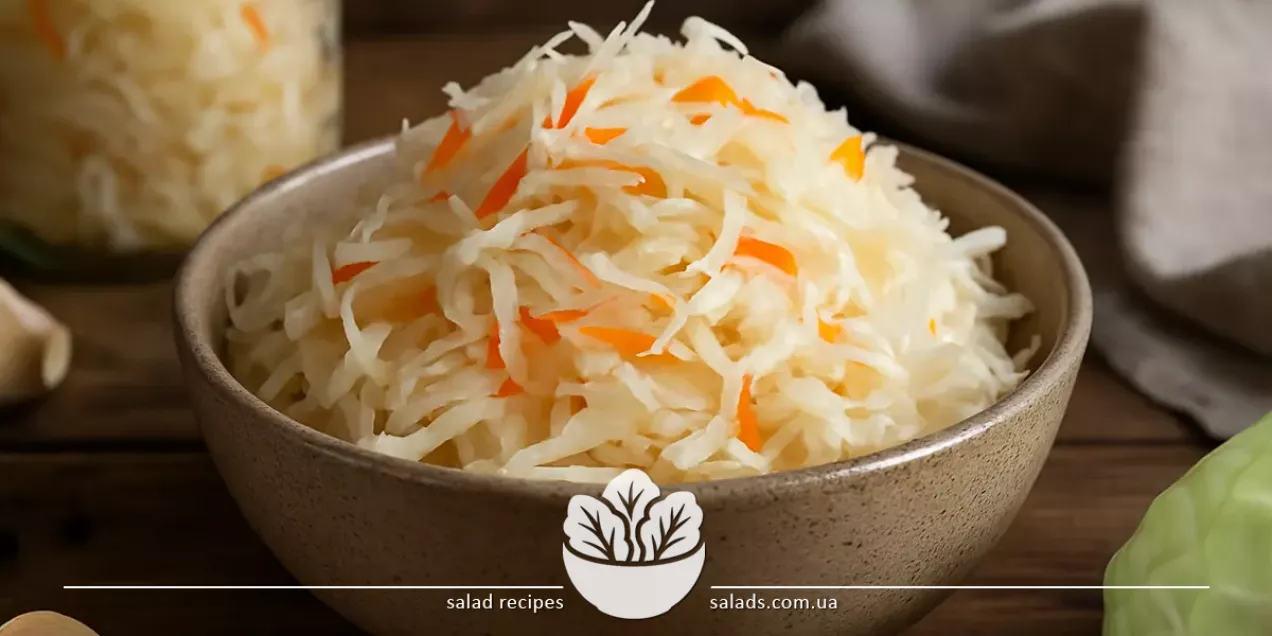Sauerkraut

Sauerkraut is a fermented vegetable product made through the natural fermentation of fresh cabbage with added salt, sometimes carrots, and spices. Thanks to its crisp texture, tangy flavor, and health benefits, it holds a key place in many Ukrainian dishes. It is enjoyed both cold – in salads and appetizers – and hot – in soups, braised vegetables, and pies. To learn more about other types of cabbage, visit the corresponding section.
Salad Recipes with Sauerkraut
Sauerkraut is a traditional Ukrainian ingredient that adds pleasant acidity, crunch, and nutritional value to salads. The simplest and most well-known version is sauerkraut salad with onions and sunflower oil, often served as a starter for main courses. In winter menus, a popular salad includes cabbage, boiled potatoes, carrots, pickles, and beans – a hearty and flavorful dish with folk character. Another common version combines sauerkraut with beets, onions, and garlic, dressed with oil – featuring a bright color and spicy taste. Apples, cranberries, or pomegranate are also added to create refreshing salads with fruity tartness. When paired with smoked meats such as ham or brisket, sauerkraut becomes the base of hearty appetizers for festive tables. It is also often mixed with carrots, peppers, and herbs to create a vitamin-rich blend that is especially valued in the cold season.
Health Benefits and Nutritional Value of Sauerkraut
Sauerkraut is not just a side dish or meal ingredient but a true source of health benefits. Through natural fermentation, it becomes enriched with lactic acid bacteria that positively affect gut flora, improve digestion, and support the immune system. This product contains vitamins C, K, and B group, as well as minerals like iron, calcium, potassium, and magnesium. In addition to its probiotic properties, sauerkraut is low in calories (about 20 kcal per 100 g), high in dietary fiber, and virtually fat-free. For this reason, it is often included in diets aimed at healthy eating or weight management. It promotes a feeling of fullness without excess calories. Combined with other simple ingredients – such as yellow onion – sauerkraut's flavor becomes even more pronounced. This combination works well in both light salads and hot dishes where maintaining the vegetable's crunch and brightness is important.
Using Sauerkraut in Hot Dishes
Sauerkraut is an essential ingredient in a wide range of hot dishes. It is perfect for braising with vegetables, meat, or sausages, adding a characteristic tang and depth to the food. When heated, sauerkraut retains some of its crunch – especially if it is only lightly cooked until tender. Classic dishes with sauerkraut include bigos, braised cabbage with pork, fried pies, kapusniak (cabbage soup), and vegetable stew. In these recipes, the cabbage serves not only as a flavor accent but also as a structural base. Its natural acidity balances the richness of meat products, adds freshness, and enhances aroma. Most often, it is braised with pork that has been pre-fried to a golden crust. This combination is the foundation of many regional dishes where the flavor of meat merges with the tang of fermented cabbage to create a deep, warming profile. Carrots, onions, tomatoes, or spices may be added as needed to boost aroma.
Sauerkraut in Salads and Cold Appetizers
In its raw form, sauerkraut is a popular base for salads and cold starters. Its crunchy texture, distinctive acidity, and high biological value make it an ideal ingredient for daily consumption without cooking. These dishes are not only tasty but also light, nutritious, and easy to digest. Sauerkraut salads can be simple or complex. The most common version combines cabbage with onion, carrot, herbs, and oil. For a richer taste, apples, cranberries, nuts, or beans are often added. These combinations create an ideal balance between freshness, acidity, and sweet notes. Among traditional appetizers, sauerkraut with carrots stands out – ready to eat immediately or after a brief marinade with oil and spices. This duo is one of the oldest methods of preserving vegetables for winter, still popular today for its simplicity, benefits, and appealing taste.
Sauerkraut Paired with Potatoes
One of the most common and successful pairings is sauerkraut with potatoes. These two ingredients complement each other perfectly: cabbage adds tang, texture, and aroma, while potatoes provide satiety and softness. Together, they form a classic duo used in salads, side dishes, pies, or main courses. One of the simplest options is serving sauerkraut as a side for boiled or fried potatoes. In this form, it refreshes the flavor of the meal, balances out fat, and adds brightness. Baking sauerkraut together with potatoes – in casseroles or pies – creates a complete dish with or without meat. Traditional Ukrainian recipes often combine sauerkraut with potatoes in mashed form or as fillings for dumplings and pastries. It’s delicious, nourishing, and highly economical. With added onions or mushrooms, the dish becomes even more satisfying and suitable for both everyday meals and holidays.
Pairing with Meat and Sausages
Sauerkraut pairs well not only with vegetables but also with various types of meat and sausages. Its natural acidity helps balance the fattiness of animal products, making dishes easier to digest. This is especially useful in braised meals, casseroles, or simple skillet dishes. The most popular classic combination is sauerkraut with boiled sausage fried until golden. This duo is often prepared as a quick hot lunch or dinner, complemented with herbs, spices, or mustard. The sausage adds juiciness, while the cabbage provides texture and a pleasant tang. Another common option is braised sauerkraut with pieces of pork sautéed with onions. During cooking, the ingredients blend flavors to create a dense, deep taste composition. This is a versatile dish that stores well, reheats easily, and suits any season.